




An Introduction to Temperature and the Facts Related to It
A group of friends is relaxing on weekends. After a day of hiking in the mountains through a forest, all of a sudden there is snowfall and everyone starts feeling cold. In order to cope with this coldness, they curl up in blankets and within a few minutes, they start feeling warm. So, what makes us say that they are feeling hot or cold? It is the temperature.

Hot and Cold
What is Temperature?
Temperature is a measurement of the hotness and coldness of a body. Scientifically, we could say that temperature is generally a measure of the kinetic energy of particles in an object, which means particles present in the object are always moving.
How is Temperature Measured?
There are many techniques to gauge the temperature, but a thermometer is the most popular one. A thermometer which is a long tube having Mercury filled in or sometimes alcohol is a tool used to gauge a substance's temperature. As you can see in the diagram given below:
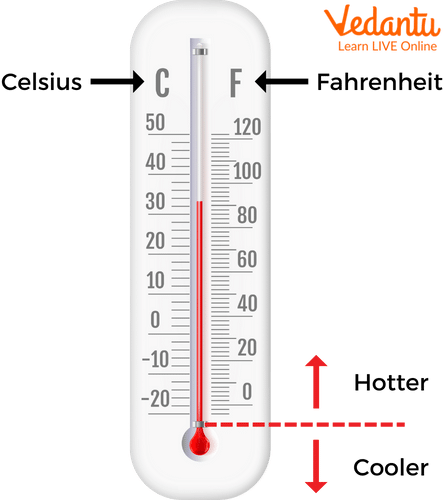
Celsius and Fahrenheit on a Scale
Here, the red line that you see is mercury, which is used to measure the temperature. The moment mercury goes up, it means the temperature is hotter, and when it goes down, it indicates that the temperature is cooler.
What are the Different Types of Temperature Scales?
There are three main temperature scales used for thermometers that are Celsius, Kinetic, and Fahrenheit. The two most widely used temperature scales are Fahrenheit and Celsius.
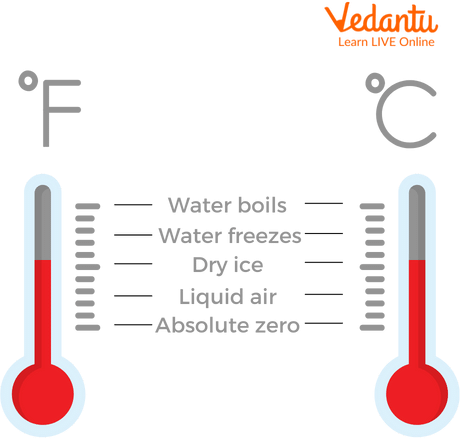
Scales and Their Properties
1. Kelvins
0°K is the lowest temperature possible.
Particles have no kinetic energy.
It is used by scientists.
2. Celcius
The absolute zero temperature is -273°.
It is used in most other countries.
It is expressed by the symbols °C.
3. Fahrenheit
The absolute zero temperature is -459°F.
It is used by the United States.
°F is expressed by the symbol °F.
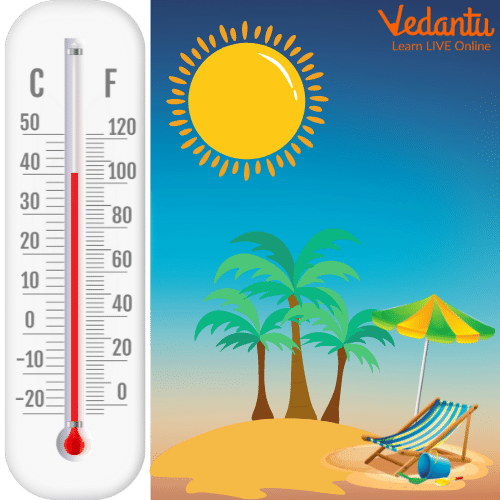
Recognising Hot Temperatures
In the above picture, the red line is at the top. This means that the weather is hot, and we frequently go swimming, wear shorts, eat cold foods and use coolers during this time.
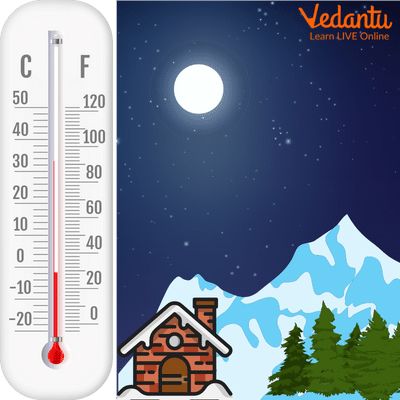
Recognising Cold Temperature
In the above picture, the red line in the thermometer is at the bottom, which means that the temperature is low and frozen. At this time, we wear warm clothes, have hot drinks, use heaters, etc.
What is the Difference Between Heat and Temperature?
The temperature is the main source of measurement of the system's kinetic energy, such as the energy of the gas. When gas is hotter, the molecules move with a high rate of randomness. When gas is colder, the molecules are moving at a lower rate of kinetic energy.
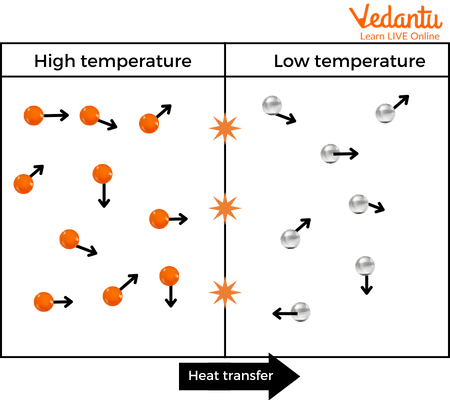
Heat Reaction to Temperature
Heat is energy that is in motion because of a temperature differential. The object with more kinetic energy gives the object with less kinetic energy its momentum. This is called heat transfer.
Temperature and the Human Body
Since temperature has an impact on various physiological functions, maintaining a healthy and functional body temperature is crucial. Human bodies typically have a temperature of 36.5 - 37.5 °C. Bodies can operate normally at this temperature. Our body temperature increasing might be a sign of illness and is referred to as a fever. This is a result of our bodies exerting more effort to ward off illness.
How Does Climate Change Affect the Temperature on Earth?
Many people associate global warming with climate change. Scientists prefer to refer to the complicated changes currently influencing our planet's climate as "climate change". Rising temperatures, changing wildlife populations and ecosystems, rising oceans, and a variety of other factors are all under the climate change umbrella. Greenhouse gases are making it more pronounced.
Summary
The article discusses the concept of temperature and its measurement using the Fahrenheit and Celsius scale. We have also learnt how heat and temperature are different concerning their properties.
Temperature is also a cause for our bodies getting affected physically. The rise of the temperature is linked with increasing global warming, which subsequently has led to glacier melting, wildlife damage, etc.
FAQs on What is Temperature? Facts about Temperature for Kids
1. How does temperature affect photosynthesis?
Temperature is one of the factors that can affect photosynthesis. The hotter the temperature, the more energy is available for photosynthesis. This is because the energy is used to break down the water and carbon dioxide into oxygen and carbon. The optimum temperature for photosynthesis varies depending on the type of plant, most likely 18°C and 24°C.
2. How does temperature affect the rate of chemical reaction?
The following reason will determine the effect of temperature on the rate of a chemical reaction. The temperature has a general impact on reaction rates. The reaction will occur faster as the temperature rises. This is due to the fact that at higher temperatures, particles in a reaction move more quickly. The molecules are in motion and interact with one another during a chemical reaction. This enhances the likelihood that two molecules will interact.









